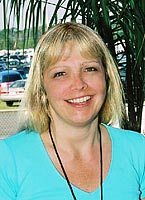|

8/9/04
 What's
the task force to do? What's
the task force to do?
No one should be surprised in the least if six months from now, NHRA
drag racing operates pretty much the same as it does right now.
Has NHRA done anything to try to make Top Fuel dragsters and Funny Cars
safer following Darrell Russell's June 27 fatality at St. Louis?
Certainly. They ordered roll-cage shielding for dragsters and announced
a new Goodyear tire for both nitro classes June 30. Nine days later
they added two more rule changes: a minimum rear-tire pressure (7
pounds per square inch for Top Fuel, 6.5 for Funny Car) and a reduction
in the maximum allowed percentage of nitromethane in the fuel mix (from
90 to 85).
That July 9 announcement included news of a task force "to evaluate and
recommend short-term and long-term performance parameters."
Bill Miller, who fields the Top Fuel dragster Brady Kalivoda drives and
manufactures pistons and connecting rods for racing engines, said
nobody can complain that NHRA didn't act swiftly: "Within 14 days, NHRA
initiated rule changes to slow the cars down. Bam -- bam. That's not
sitting on the toilet."
Miller sits on the task force, though, and he cautioned that the group
is called the Top Fuel and Funny Car Performance Limitation Task Force.
Team owner Don Schumacher stressed safety when he spoke about serving
on the panel. But Miller said safety isn't the group's primary concern:
"That's not its purpose."
So let's not be na‘ve. Miller and fellow task-force member Austin Coil
of John Force Racing were among those who spoke candidly about what has
happened since the St. Louis race. And it seems any safety improvements
that might stem from these latest rules or any further edicts merely
would be happy coincidences. In other words, don't hold your breath
waiting for sweeping safety changes.
Of course, nobody at Goodyear purposely designed a tire that would fail
and cause a catastrophic accident. For that matter, nobody has pointed
an official finger at any corporation or individual, although Russell's
widow, Julie, is quoted in the Los Angeles Times in a July 28 article
as saying her husband "expressed a lot of concern" about the tires "on
many occasions" and that officials "knew there was a problem." And
nobody is taking Russell's death lightly.
However, safety is not an issue on which the task force is focusing.
Take, for example, the nitro-mix issue.
Coil said NHRA management is "concerned about the sound of thunder and
fire out the headers and all the things that make the cars exciting to
their fans. And they don't want to lose that at all. As a matter of
fact, one of the NHRA people told me that if this doesn't turn out to
be what they need that they might very well go back to 90 percent at
some time in the near future."
Just before putting the finishing touches on Force's No. 1 qualifying
effort at Seattle, Coil said, "I'm real concerned how these cars sound
now on 85 percent. To me, it's quite a bit different. I don't know how
it is to the rest of the fans, but to me they sound so pitiful." For
however pitiful it was, it was plenty powerful. Force earned his NHRA
record 112th victory and ran one of just two 4.8-second elapsed times
during eliminations.
Dickie Venables, crew chief for Tony Pedregon's Quaker State Chevy
Monte Carlo Funny Car, said the reduction in the fuel's nitromethane
limit from 90 to 85 percent was not significant, that it wouldn't
hinder his team. "We have a lot of other knobs that will make us more
power," he said. "It's not like everybody's going to be content.
They'll try to make up for what's been taken away."
How hard will crew chiefs argue to keep that percentage high enough not to
actually slow down the cars? Coil said, "There
is a point somewhere if you just kept reducing
the nitro percentage that you couldn't compensate
with the tools available. If you got low enough
percentage - - and I don't claim to know where
that is -- it would most definitely be slower.
I'm afraid they would sound way too anemic,
and that's probably not a good option for the
future."

|